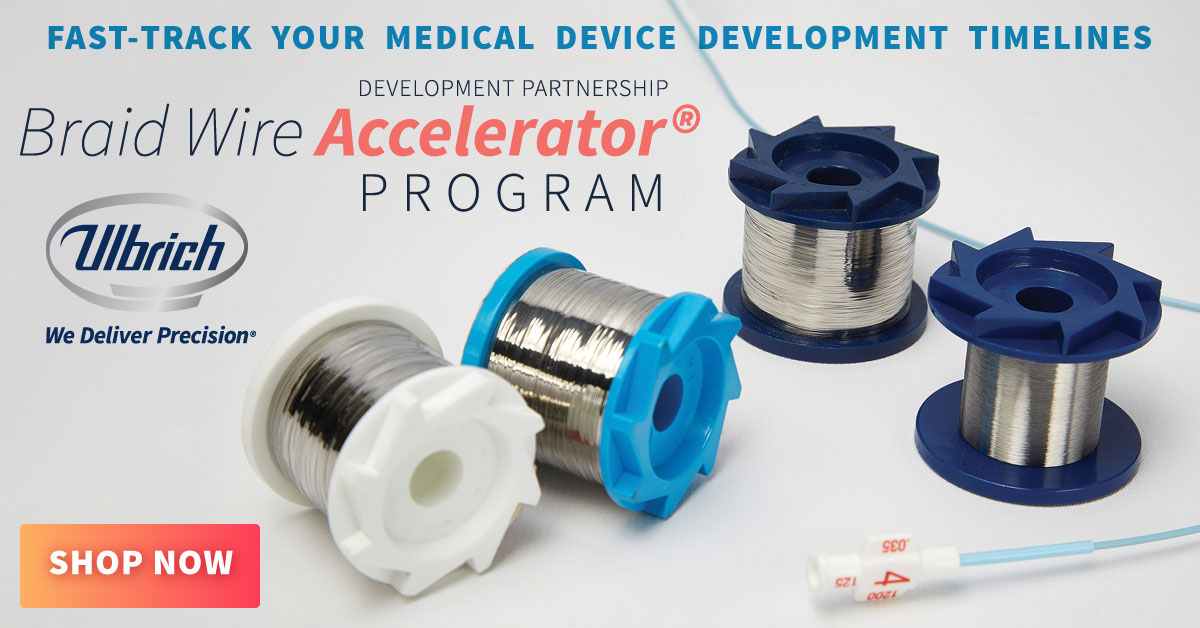In this interview, Ryan McFarland, the Medical Product Manager at Ulbrich Speciality Wire Products, talks to AZoMaterials about the use of raw materials in medical applications.
How has the medical field changed over the past decade for clients?
The rate of innovation has accelerated, and new devices and therapies are developed much more frequently. Some startups grow quickly, others fizzle, and the rate of mergers and acquisitions also seems to be increasing. There has also been incredible growth in robotics technology that could help the medical field meet previously unmet patient needs and serve underserved communities.

Image Credit: ShutterStock/PopTika
How has Ulbrich helped clients to embrace these changes?
Our Braid Wire Accelerator program was developed to speed up the supply chain to meet ever-shortening medical device development timelines. We're constantly adapting our products, processes, and procedures to allow us to innovate as fast as the industry. Additionally, we've expanded our R&D efforts to work directly with customers to meet their evolving needs.
Why is it essential for Ulbrich to understand medical device development timelines?
The better we understand our customers' forecasted demand, the more we can stay on top of raw material needs and allocate production equipment. The better we know timelines, the better we can meet material needs. That said, we work on many prototypes, so we understand the iterative nature of medical device development and its unique challenges that can demand adaptability.
What products typically make use of Ulbrich's Specialty Wire division's materials?
Industries that use our product include high-performance cable, electronics, solar, medical, and music manufacturers.

Image Credit: ShutterStock/Philip Steury Photography
Our fine wire products are used in various applications, from medical braid wire to high-performance cables, solar panels, and more. We use stainless steel, nitinol, copper, nickel, cobalt, carbon, aluminum, titanium, and many other materials.
Why is it essential to offer a range of wire forms?
Different applications require vastly different material properties. Ulbrich Wire Group can provide fine wire products to exact dimensional tolerances and physical properties. Our process engineers, tooling experts, drawing and rolling mill engineers produce highly engineered wire products for critical applications.
Our skilled staff of engineers and metallurgists offer exceptional knowledge in product development and prototyping for the most challenging applications.
What medical uses are there for these materials?
Ulbrich's Specialty Wire divisions supply materials used to braid metal-reinforced catheter tubing, implantable material, and medical mandrels, among other medical applications.
What special considerations must be made for products in this field?
Extreme accuracy and precision are critical when supplying material for medical braid wire. Additionally, there are special packaging considerations: a bad wrap or incorrect tension on a bobbin can make braiding difficult.
To meet our medical braid wire customers' exacting needs, we tightly control dimensional and mechanical properties during our manufacturing processes.
What is the Braid Wire Accelerator® Program?
As development timelines continue to shrink, it's only becoming more important that medical device designers can iterate quickly. The problem is the supply chain rarely supports it. We've developed our Braid Wire Accelerator® Program to rapidly deliver round & flat wire materials for critical medical manufacturing needs.
What benefits can Ulbrich's clients gain from this program?
Our Braid Wire Accelerator® offers our clients two distinct options. Suppose their needs fall within our standard stock of materials and dimensions. In that case, the standard accelerator program offers enhanced delivery times to ensure the wire they need reaches their facilities as quickly as possible.
If a client requires minor modifications to meet spec, we also offer a Rapid Prototype, semi-finished-materials program. This may mean a refinement of the dimensions of a standard stock wire or a tweak to its properties or finish.
Rapid Prototype also offers quick lead times and low MOQs, but the lead times and MOQs are both slightly larger than the standard program.

Image Credit: Ulbrich Steels
What pressures do Ulbrich's clients face, and how does Ulbrich help alleviate them?
Depending on clients' products' lifecycle, there can be discrepancies between forecasts and actual demand. We try our best to keep lines of communication open, and if demand for one product is decreasing, we can use that material for another product. This is possible because a lot of products are used in similar applications.
How does Ulbrich's extensive R&D knowledge benefit its clients?
Our experts can help reduce the iterative process based on past knowledge and predictive analysis of material properties.
Why is a global structure so important?
There has been a marked increase in preventative surgeries in emerging markets worldwide. Many surgeries involve heart valves, stents, and other devices that utilize products like ours. We're proud to ship medical products around the world and help this expansion of preventative care.

Image Credit: ShutterStock/UfaBizPhoto
What improvements in processes and products is Ulbrich currently working on?
We're continually expanding the inventory of our Braid Wire Accelerator to match industry trends. There's also a continuous improvement of our manufacturing processes to become more efficient and sustainable. These improvements include a recycling program for our packaging spools and bobbins and swapping cardboard for reusable totes.
Where can readers find more information?
Check out the website for our Braid Wire Accelerator, https://www.ulbrich.com/braid-wire-accelerator-program/
About Ryan McFarland
Ryan McFarland is the Medical Product Manager at Ulbrich Specialty Wire Products division since 2015. As a way of background, he earned his BS in Mechanical Engineering at Drexel University and MBA at Saint Joseph's University. Ryan has been involved in the medical industry for over 20 years.
As the Medical Product Manager, Ryan is responsible for helping to set the product line strategy for the Medical Wire Product, implementing the strategy to Sales, coordinating with Marketing for different campaigns, and helping to drive new product development in the product line, all on a Global platform. The Medical Wire Product line has grown at a double-digit rate for years and even more aggressively over the past several years. Several successful NPI projects, including Nitinol and medical mandrel wires, were implemented during Ryan's tenure.
About Ulbrich Specialty Wire Products
Ulbrich Specialty Wire Products, located in Westminster, South Carolina, is equipped for rolling, drawing, annealing, straightening, and precision winding of various round, flat and square wire products. Our expertise and state-of-the-art equipment allow us to meet the precision requirements of innovative manufacturers of medical devices, high-performance cables, and more.

This information has been sourced, reviewed, and adapted from materials provided by Ulbrich Stainless Steels & Special Metals, Inc.
For more information on this source, please visit Ulbrich Stainless Steels & Special Metals, Inc.
Disclaimer: The views expressed here are those of the interviewee and do not necessarily represent the views of AZoM.com Limited (T/A) AZoNetwork, the owner and operator of this website. This disclaimer forms part of the Terms and Conditions of use of this website.